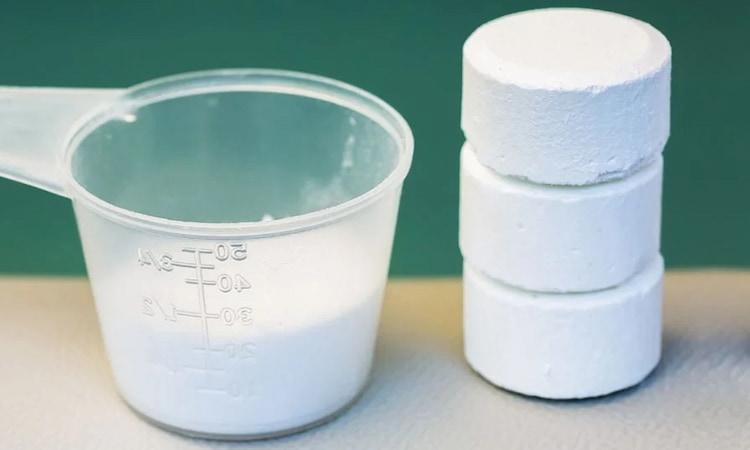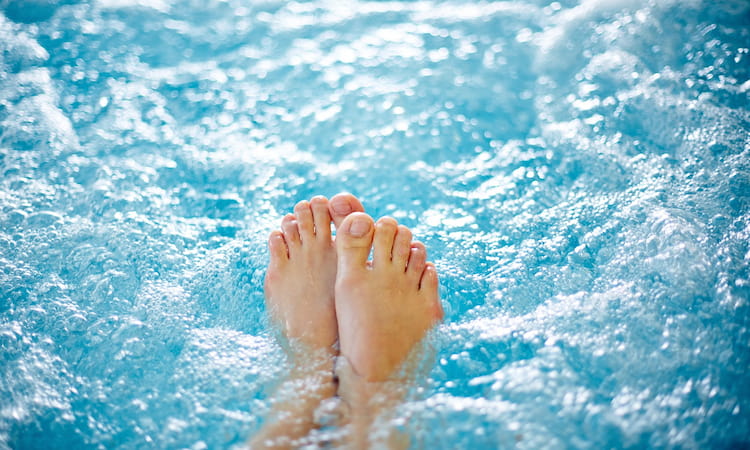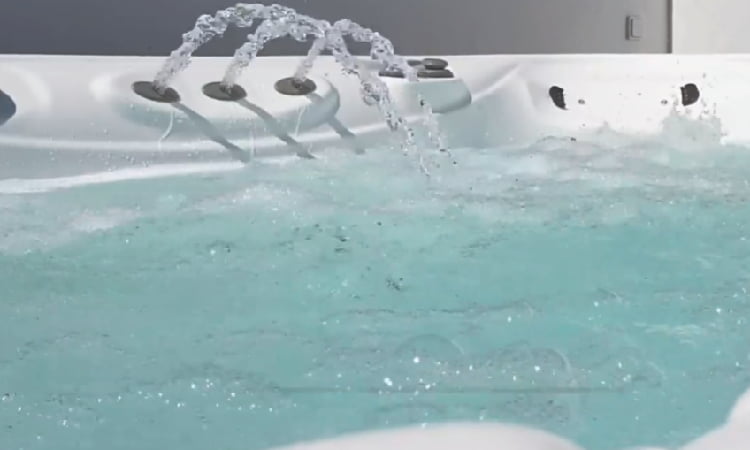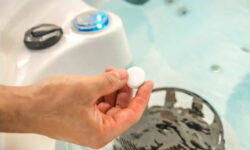You’ve noticed your hot tub’s chlorine levels are sky-high and you’re not sure what to do. Don’t fret! Too much chlorine can be harmful, but you’ve got options to lower those levels and prevent damage.
To decrease chlorine in a hot tub, stop adding chlorine and let it naturally evaporate over time. Ensure the hot tub cover is off to allow the chlorine to dissipate faster. You can also add a chlorine neutralizer, available in pool supply stores, to speed up the process.
In this guide, we’ll show you how to identify excessive chlorine, understand its effects, and introduce three effective methods to decrease it. So let’s dive in and get your hot tub back to a safe, enjoyable oasis.

Quick Navigation
- How to Know if You Have Too Much Chlorine in Your Hot Tub?
- How Long Does it Take For Chlorine to Lower in Your Hot Tub?
- Easy Ways to Lower Chlorine Levels in Your Hot Tub
- Can Too Much Chlorine Damage Your Hot Tub?
- Potential Health Effects of Too Much Chlorine in The Hot Tub
- Frequently Asked Questions
- Conclusion
How to Know if You Have Too Much Chlorine in Your Hot Tub?
Before you can start reducing chlorine in your hot tub, it’s crucial to know when you’ve got too much of it in the first place. The signs of excessive chlorine are not always obvious, but they’re important to recognize for the safety and comfort of those using the tub.
If you’re experiencing eye or skin irritation after using your hot tub, this is a common indicator that the chlorine level is too high. You may also notice an unusually strong chlorine smell or even visible cloudiness in the water. Bleaching of swimsuits or hot tub covers can also be a sign.
To confirm your suspicions, you’ll need a reliable testing kit. These kits measure the parts per million (ppm) of chlorine in your water.
For hot tubs, the ideal chlorine level is between 1.0 and 3.0 ppm. If your test results show a level higher than 3.0 ppm, it’s time to take action to reduce the amount of chlorine in your hot tub.
How Long Does it Take For Chlorine to Lower in Your Hot Tub?
You might be wondering how long it takes for the chlorine levels in your hot tub to decrease. This is a crucial aspect of the maintenance of your hot tub, and it’s important to know that the time it takes can vary based on several factors.

The most significant factor is the amount of chlorine you’ve initially added. If you’ve over-chlorinated your hot tub, it could take up to a week for the chlorine levels to return to a safe range. However, if you’ve maintained a balanced chlorine level, it usually takes between 24 to 48 hours for chlorine to evaporate naturally.
Another factor is the temperature of the water in your hot tub. Warmer water tends to accelerate the evaporation process, causing chlorine levels to drop more rapidly. Your hot tub’s exposure to sunlight also plays a role, ultraviolet rays from the sun can rapidly decrease chlorine levels.
It’s also worth noting that the use of your hot tub influences the chlorine levels. The more your hot tub is used, the faster the chlorine will dissipate. So, keep these factors in mind while you wait for the chlorine levels to drop in your hot tub.
Easy Ways to Lower Chlorine Levels in Your Hot Tub
While it’s essential to have some chlorine in your hot tub to kill bacteria, too much can cause skin irritation and other problems, so let’s explore a few ways to lower these levels.
Here are some methods you can use:
- Decrease the Chlorinator Setting: If your hot tub uses an automatic chlorinator, adjusting its setting to a lower level can help reduce the amount of chlorine released into the water.
- Use a Neutralizer: Chlorine neutralizers, available at pool supply stores, can reduce high chlorine levels effectively. They’re easy to use – just follow the instructions on the package.
- Let it Dissipate Naturally: Chlorine will naturally dissipate over time. If you’re not in a rush, simply leaving your hot tub uncovered and not using it for a few days can help.
- Perform a Partial Water Change: By removing some of the chlorinated water and replacing it with fresh water, you can lower the concentration of chlorine in your hot tub.
Can Too Much Chlorine Damage Your Hot Tub?
Excessive chlorine in your hot tub can indeed cause damage, and it’s not just to your skin or swimsuit.
Over time, too much chlorine can lead to corrosion of your hot tub’s equipment and surfaces. This could mean costly repairs or replacements down the line.
For instance, high chlorine levels can corrode the heater element in your tub, leading to its premature failure. The pump, which circulates water and chemicals throughout the tub, can also become damaged. This can manifest as mechanical issues or a reduction in the pump’s overall lifespan.
The tub’s surface and cover are not immune either. The vinyl liner and plastic components can become brittle and crack under the harsh effects of excessive chlorine. Your tub’s cover can also deteriorate, losing its insulating properties and causing your energy costs to spike.
To avoid these potentially expensive problems, it’s essential to monitor and maintain the right balance of chemicals in your hot tub. Regular testing and adjusting of your tub’s chlorine levels not only ensures a safe and enjoyable soak but also extends the life of your hot tub and its components.
Potential Health Effects of Too Much Chlorine in The Hot Tub

Surprisingly, too much chlorine in your hot tub can pose a significant health risk, and it’s an issue that shouldn’t be overlooked.
It is not just about the unpleasant smell or the stinging eyes, it’s more than that. Overexposure to chlorine can lead to severe health issues that can affect your skin, respiratory system, and even your vision.
Here are some potential health effects of excessive chlorine in your hot tub:
- Skin Irritation: High chlorine levels can cause dry, itchy skin, and prolonged exposure may even lead to dermatitis.
- Respiratory Problems: Inhaling the strong fumes of chlorine can lead to respiratory issues like asthma and bronchitis.
- Eye Damage: Chlorine can cause red, irritated eyes, and over time, it may even result in blurry vision or other vision problems.
- Allergic Reactions: Some individuals may develop an allergy to chlorine, causing symptoms like sneezing, rashes, or even anaphylaxis in severe cases.
Frequently Asked Questions
You can use alternatives to chlorine in your hot tub like bromine, biguanide, or mineral purifiers. They’re effective sanitizers and gentler on the skin. Remember, always follow the manufacturer’s instructions for best results and safety.
When you heat your hot tub, it accelerates chlorine’s evaporation rate. So, higher temperatures can actually reduce chlorine levels quickly. It’s vital to monitor and adjust these levels for optimal sanitation and comfort.
Even if you’re not experiencing symptoms, it’s unwise to use your hot tub when chlorine levels are high. Overexposure can lead to health issues like skin irritation or breathing problems over time.
You should test your hot tub’s chlorine levels at least twice a week. If you’re using it frequently, it’s advisable to test more often to ensure a safe and hygienic soaking environment.
No, it’s not safe to mix chlorine with other hot tub chemicals. Chemical reactions could occur, leading to dangerous gases or explosions. Always add chemicals separately, and wait for each to dissolve fully before adding another.
Conclusion
In conclusion, having too much chlorine in your hot tub can be harmful to both your health and the hot tub itself. It’s important to regularly check chlorine levels and take steps to lower them if necessary.
Remember, it can take some time for chlorine levels to decrease. Stay informed and cautious about your hot tub maintenance to ensure a safe and enjoyable relaxation experience.


![What is a Stabilizer in a Hot Tub? [Types of Stabilizers] what is a stabilizer in hot tubs and how does it work](https://hottubtales.com/wp-content/uploads/2023/10/what-is-a-stabilizer-in-hot-tubs-and-how-does-it-work-250x150.jpg)
![Can You Over Shock a Hot Tub? [What to Do if You Did?] can you over shock a hot tub](https://hottubtales.com/wp-content/uploads/2023/10/can-you-over-shock-a-hot-tub-250x150.jpg)
![How to Lower Bromine Level in Hot Tub? [& Signs of High Levels] how to lower bromine level in hot tub](https://hottubtales.com/wp-content/uploads/2023/10/how-to-lower-bromine-level-in-hot-tub.jpg)

